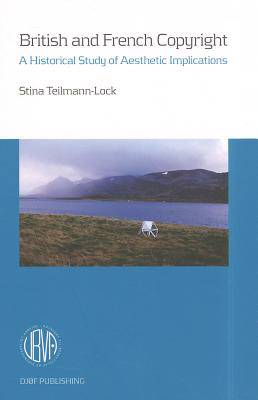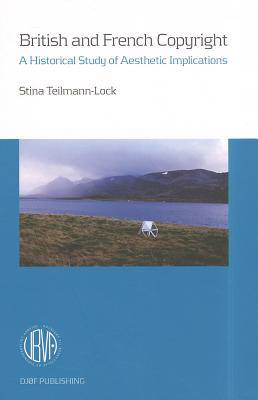
Door een staking bij bpost kan je online bestelling op dit moment iets langer onderweg zijn dan voorzien. Dringend iets nodig? Onze winkels ontvangen jou met open armen!
- Afhalen na 1 uur in een winkel met voorraad
- Gratis thuislevering in België vanaf € 30
- Ruim aanbod met 7 miljoen producten
Door een staking bij bpost kan je online bestelling op dit moment iets langer onderweg zijn dan voorzien. Dringend iets nodig? Onze winkels ontvangen jou met open armen!
- Afhalen na 1 uur in een winkel met voorraad
- Gratis thuislevering in België vanaf € 30
- Ruim aanbod met 7 miljoen producten
Zoeken
British and French Copyright
A Historical Study of Aesthetic Implications
Stina Teilmann-Lock
Paperback | Engels
€ 41,95
+ 83 punten
Omschrijving
This book offers an aesthetic account of intellectual property rights as they concern works of art and literature. The thesis begins with a comparison of British copyright and French droit d'auteur, and goes through a historical survey of licenses and printing privileges in both countries, including the Statute of Anne of 1710 as well as the Fine Arts Act of 1862 in Britain, and La loi du 19 juillet 1793 in France. The core of the thesis is a reading of selected legal cases in Britain and France from the early 19th century to the present. Cases concerning works of art and literature are closely analyzed and compared in terms of their concern and consequences for the scope of protection, the justification for copyright, the concept of the work and of the author/creator, the notion of originality, and the concepts of copying and infringement. Cases are presented chronologically in order to expose trends and developments. It presents, in outline, a conceptual history of reproduction (as substitution, as multiplication, as appropriation), in order to understand the legal conflicts and inconsistencies in copyright law. These particularly concern the disparity between the ownership of an immaterial work and that of its material manifestation, as well as the lack of an appropriate legal distinction between images and texts. Dissertation.
Specificaties
Betrokkenen
- Auteur(s):
- Uitgeverij:
Inhoud
- Aantal bladzijden:
- 265
- Taal:
- Engels
Eigenschappen
- Productcode (EAN):
- 9788757422139
- Verschijningsdatum:
- 1/12/2009
- Uitvoering:
- Paperback
- Formaat:
- Trade paperback (VS)
- Afmetingen:
- 155 mm x 229 mm
- Gewicht:
- 453 g

Alleen bij Standaard Boekhandel
+ 83 punten op je klantenkaart van Standaard Boekhandel
Beoordelingen
We publiceren alleen reviews die voldoen aan de voorwaarden voor reviews. Bekijk onze voorwaarden voor reviews.











